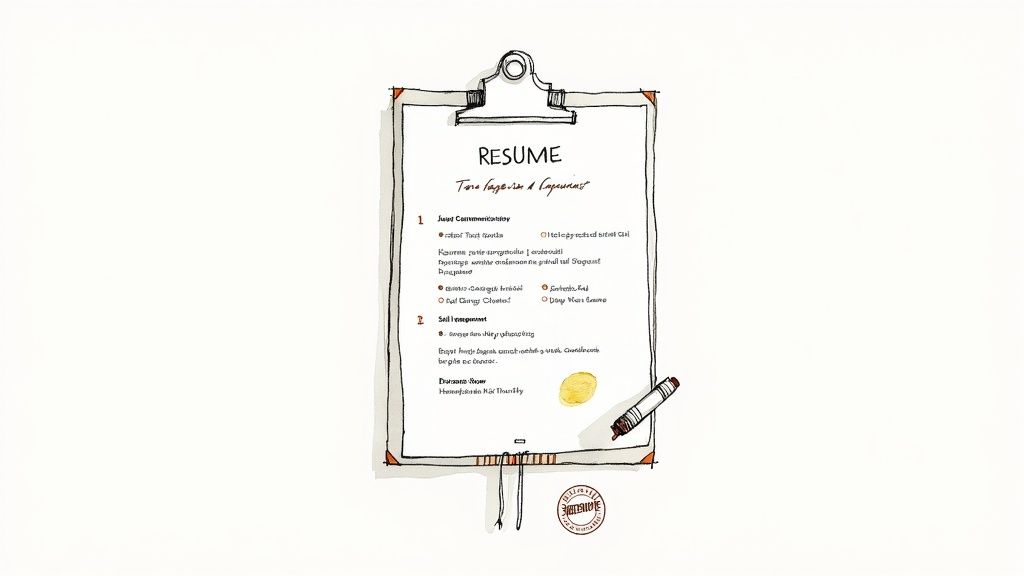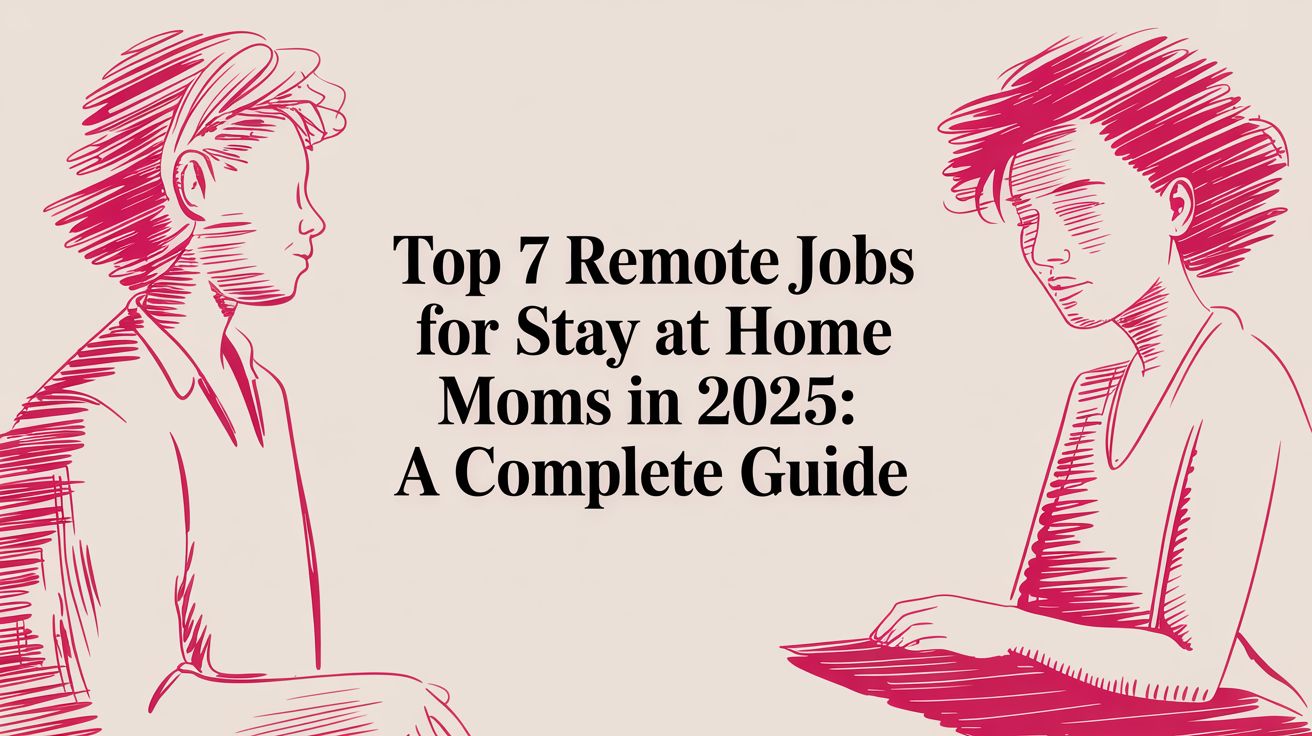Finding legitimate work from home jobs: you can trust
Max
To find a legitimate work-from-home job, you really need to zero in on three things: using the right platforms, carefully checking out every single listing, and customizing your applications. This approach is your best defense against the scams and junk offers out there, helping you land a genuine remote role you’ll love.
Navigating the Remote Job Market With Confidence

Jumping into the remote job search can feel like a lot. There are endless listings, and the fear of falling for a scam is always in the back of your mind. But here’s the good news: the game has changed, and it’s in your favor.
Companies aren’t just dipping their toes in the water anymore; many have gone all-in, building their entire culture around a remote-first mindset.
This massive shift means there’s a treasure trove of real opportunities across almost every industry you can think of—from tech and finance to creative fields and customer service. By 2023, about 28% of employees worldwide were already working remotely, and in the U.S., that number hit around 35.1 million people by August 2024. The old ways of working are fading fast.
Your Strategic Framework for Success
To find a role you can actually trust, you need a solid plan. Forget about mindlessly scrolling through generic job boards for hours. It’s time to get methodical.
A simple, three-pillar framework will not only steer you clear of phony listings but also dramatically boost your chances of getting noticed by a real hiring manager. Think of it as your roadmap to turning the job search from a game of chance into a strategic mission.
The key isn’t just finding any remote job; it’s about finding the right one. A smart strategy ensures you’re putting your time and energy into opportunities that are secure, rewarding, and a good fit for your career.
To help you visualize this, here’s a quick breakdown of the core principles we’ll be diving into.
Your Three-Pillar Strategy for a Successful Remote Job Search
| Pillar | Key Action | Why It Matters |
|---|---|---|
| Pillar 1: Credible Platforms | Focus your search on remote-specific job boards and reputable company career pages. | This is your first line of defense against scams. Legitimate platforms vet their listings, saving you from sorting through fraudulent offers. |
| Pillar 2: Diligent Vetting | Investigate every company and job listing before you apply. Look for red flags. | Protects you from scams that waste your time or, worse, compromise your personal information. It ensures the opportunity is real and the company is legitimate. |
| Pillar 3: Tailored Applications | Customize your resume and cover letter for each specific role you apply for. | Generic applications get ignored. Tailoring shows you’re serious, detail-oriented, and a perfect fit for that specific remote role, not just any role. |
By building your search around these pillars, you’re setting yourself up for success from day one. You’ll know exactly where to look, what to avoid, and how to present yourself as the ideal remote candidate.
We’ll walk through each of these steps, giving you actionable advice to confidently navigate the market. You can also get a head start by learning more about current remote work trends and what they mean for your job search.
Where to Find Vetted Remote Job Opportunities

If you’re tired of sifting through fraudulent or low-quality listings, it’s time to change where you’re looking. The first step toward finding a legitimate work-from-home job is to move away from the massive, general job boards where anything and everything gets posted.
The real key is to focus on platforms specifically built for remote work. These sites are the gatekeepers, curating their listings and often vetting companies to make sure they’re the real deal. This simple shift means you spend less time dodging scams and more time finding roles that actually match your skills.
Remote-First Job Boards
Your best bet is to start with job boards built exclusively for remote work. Unlike the giant aggregators, their entire business model revolves around connecting talented professionals with companies that genuinely embrace a remote culture. Think of them as a pre-vetted talent pool.
These sites often charge companies to post a listing, which is a simple but effective way to weed out most of the scammers from the get-go.
- FlexJobs: Known for its hand-screened listings, FlexJobs guarantees every single job on its platform is legitimate and offers some form of work flexibility.
- We Work Remotely: As one of the largest remote communities out there, it’s a go-to for high-quality roles, especially in the tech and startup world.
- Remote.co: This site not only curates a great list of remote jobs but also provides a ton of helpful resources for anyone navigating the remote job market.
A pro tip for using these boards: set up hyper-specific job alerts. Instead of a broad alert for “marketing,” get granular with something like “remote content marketing manager.” You’ll get highly relevant roles sent straight to your inbox.
For a much deeper dive, check out our guide on the best remote job websites. It’ll give you a whole roster of vetted sources to add to your daily search routine.
Industry-Specific Niche Sites
If you’re in a specialized field like tech, design, or writing, niche job boards can feel like a goldmine. These platforms cater to a very specific audience, which means the jobs are way more relevant and posted by companies that actually get your industry.
A software developer, for instance, is going to have much better luck on a tech-focused board than on a general one. Likewise, a graphic designer will probably find higher-caliber freelance gigs or full-time roles on a site dedicated to creatives.
Direct Company Career Pages
Here’s one of the most overlooked—but most effective—strategies: go straight to the source. Make a list of companies known for their awesome remote culture (think GitLab, Zapier, or Automattic) and bookmark their career pages.
This direct approach pays off in a few ways. You’ll often be the first to see new openings before they hit the big job boards, and it lets you show genuine interest in that specific company’s mission, which is a huge plus for hiring managers.
It’s also smart to keep the current market in mind. As of late 2025, around 66% of remote job openings are for experienced professionals, with only 7% targeting entry-level roles. Certain fields like engineering and consulting, however, have seen a big jump in remote postings. This kind of targeted thinking helps you focus your energy where it counts—on companies that are actively hiring for your exact skill set.
How to Spot and Avoid Work From Home Job Scams

Let’s be honest: the biggest hurdle in finding a great remote job isn’t the lack of openings. It’s cutting through the noise and dodging the countless scams that litter job boards. These fake listings are designed to prey on your excitement, turning a hopeful job hunt into a total nightmare.
Scammers are getting much more sophisticated. The days of obviously fake, poorly written emails are mostly behind us. Now, they’re building convincing job posts and even entire sham company websites. Your new job, before you even get a job, is to become a bit of a detective. You have to learn to spot the small details that give the game away.
An Unprofessional (and Weird) Interview Process
One of the loudest alarm bells is a hiring process that just feels… off. A real company is going to invest time and resources into getting to know you. You can expect structured interviews, usually over video, often with several different people from the team.
Scammers, on the other hand, want to rush you through the process before you catch on, and they definitely don’t want you to see their face. This is why they often rely on instant messaging for the entire “interview.”
Keep an eye out for these massive warning signs:
- Interviews happen only via text. If a “recruiter” insists on conducting the whole interview on an app like Telegram, WhatsApp, or Google Hangouts, that’s your cue to be extremely skeptical. Real companies use video calls.
- They make an offer on the spot. Legitimate hiring is a process. It takes time. Getting a job offer immediately after a short text chat isn’t lucky—it’s a classic pressure tactic designed to make you act before your brain can catch up to your excitement.
- Their answers are vague or evasive. Ask specific questions. What are the day-to-day duties? What’s the team structure like? What’s the company culture? If you get back generic, buzzword-filled sentences that don’t actually answer your question, they’re hiding something.
Many of these scams use fake profiles and stock photos to appear legitimate. Learning how to check if a photo is real is a surprisingly useful skill in vetting these sketchy “recruiters.”
The “Pay to Play” Scheme
This is the oldest scam in the book, yet it still works because it taps into a job seeker’s eagerness. Let’s make this crystal clear: a real job pays you. You should never have to pay your employer for the privilege of working for them.
Crucial Takeaway: If any job asks you to pay for training, software, a background check, or your own equipment—especially with non-refundable methods like a wire transfer or gift cards—it’s a scam. 100% of the time.
A common scenario goes like this: You’re “hired” and told you need to buy a specific laptop and software package from their “approved vendor.” They’ll ask you to send them the money directly. The equipment, of course, never shows up, and your new “manager” vanishes.
Legit companies will either ship you the equipment you need or give you a stipend to buy it yourself from any store you choose.
Job Scam Red Flag Checklist
When that little voice in your head says something feels wrong, listen to it. Trust your gut and do some digging. Use this checklist as a quick reference to spot the common traits of a fraudulent job post.
| Red Flag | What It Looks Like in Practice | What to Do |
|---|---|---|
| Vague Job Description | The post is full of hype like “unlimited earning potential” but has almost no concrete details about the actual work. | Copy and paste a few sentences from the description into Google. Scammers often steal text from real, legitimate job listings. |
| Unprofessional Communication | Emails come from a personal address (e.g., [email protected]) and are riddled with typos or weird grammar. | A real company will always use its own domain (e.g., [email protected]). Check the company’s official website. |
| Asks for Sensitive Info Too Soon | The application demands your Social Security Number, bank account details, or a copy of your ID right away. | Never share this information until you have a signed, official offer letter and have independently verified the company is real. |
This might seem like a lot to watch out for, but staying vigilant is your best defense. To get a better feel for what real opportunities look like, our guide on finding legitimate work from home jobs can give you a solid baseline for your search.
Vetting a Company’s Remote Culture
Finding a legitimate work-from-home job is just the first hurdle. The real prize is landing a role where you can actually grow and feel valued, and that hinges almost entirely on the company’s remote culture.
A job might be real, but if the company treats its remote team like a separate, less important entity, you’re just signing up for a world of frustration. Don’t stop your detective work once you’ve confirmed a company is the real deal—that’s when the real investigation begins.
Telework is a significant part of the U.S. labor market, with 21.6% of the working population still logging in from home as of April 2025. Companies have had plenty of time to get this right. Some have built incredible, supportive remote-first environments, while others are still just… tolerating it. You can see more about these telework trends in America on eyeonhousing.org. Your job is to figure out which is which.
Reading Between the Lines
Your research should kick off long before you ever get on a call. A company’s digital footprint is a treasure trove of clues about its internal world. Start by putting on your critic’s hat and combing through their website and social media.
Are they actively celebrating their distributed team? Look for pictures of remote employees, posts about their communication philosophy, or mentions of virtual team-building events. A company that’s genuinely proud of its remote culture will be shouting it from the rooftops.
On the flip side, a generic careers page with stock photos and zero specifics about remote life is a big red flag. It often means they see remote work as a box to tick, not a culture to build. For a deeper dive, check out our guide on how to build a strong remote work culture.
Sourcing Insider Information
Next up, it’s time to get the inside scoop. Head over to employee review sites like Glassdoor. A single bad review can be an outlier, but what you’re looking for are patterns.
Are multiple people complaining about feeling isolated? Is poor communication a recurring theme? Do employees feel like management doesn’t trust them to work autonomously? These consistent threads paint a much more accurate picture of the day-to-day reality. Also, see how the company responds to negative feedback. A thoughtful, constructive reply is a great sign; radio silence or defensive comments? Not so much.
A company’s true culture isn’t found in its mission statement; it’s revealed in the consistent experiences of its employees. Look for the patterns, not the outliers.
Finally, fire up LinkedIn and do some light stalking. Is their team actually distributed? Check the locations of employees across different departments. If every single person in a leadership role is sitting in the main office while junior staff are spread out, it could point to a cultural divide.
Questions to Uncover the Truth
When you finally land that interview, it’s your chance to turn the tables and interview them. Don’t just ask, “Do you have a good remote culture?” That’s a softball question. You need to probe for specifics.
Here are a few questions I’ve found to be incredibly revealing:
- Communication: “How do you balance asynchronous communication with real-time collaboration? What’s your strategy for keeping everyone in the loop without creating endless meeting fatigue?”
- Team Building: “What specific rituals or activities does the team have to build connections when you’re not physically together?”
- Growth & Development: “How do you ensure remote employees have the exact same opportunities for career progression as their in-office colleagues? Can you give me an example?”
Their answers—or their fumbling attempts to find one—will tell you everything you need to know. You’ll quickly figure out if you’re just applying for another remote job or a place you can actually call home.
Crafting an Application That Gets Noticed
 In the world of remote work, a generic resume is the digital equivalent of junk mail—it gets deleted instantly. Hiring managers are drowning in applications and have a sixth sense for spotting candidates who just hit “apply” without a second thought.
In the world of remote work, a generic resume is the digital equivalent of junk mail—it gets deleted instantly. Hiring managers are drowning in applications and have a sixth sense for spotting candidates who just hit “apply” without a second thought.
To stand out, your application needs to do more than list past jobs. It has to tell a compelling story about why you’re the perfect person for a role that demands autonomy and a focus on results.
Showcasing Your Remote-Ready Skills
When hiring for a remote position, managers aren’t just looking for someone who can do the job. They’re looking for someone who can do it without constant supervision. This means you have to shine a spotlight on the skills that prove you’re a self-starter who thrives independently.
Your main goal is to reframe your experience to highlight these core remote work skills:
- Asynchronous Communication: Talk about your experience with tools like Slack, Asana, or Trello. Better yet, describe a project where you successfully coordinated with a team spread across different time zones.
- Self-Management and Autonomy: Don’t just say you “completed tasks.” Use action-packed language. For instance, “Independently managed a project pipeline from conception to completion, exceeding targets by 15%.”
- Proactive Problem-Solving: Give a concrete example of a time you spotted a potential issue and fixed it without waiting for instructions. This shows initiative, a golden ticket in the remote world.
For a deep dive, our guide on crafting a standout resume for remote jobs is a fantastic resource to help you translate your skills effectively: https://remotefirstjobs.com/blog/resume-for-remote-jobs
Your resume isn’t just a history of your career; it’s a marketing tool for your future. For remote roles, it must prove you can deliver incredible results with minimal hand-holding.
Tailoring Your Application to the Job Description
Think of every job description as a cheat sheet. It’s packed with the exact keywords and skills the company is searching for, and your application needs to reflect that language. An Applicant Tracking System (ATS) will almost certainly scan your resume for these terms before it ever reaches a human.
Don’t just copy and paste keywords randomly. Instead, strategically weave them into your experience descriptions. If a posting mentions “cross-functional collaboration,” make sure a bullet point on your resume details a project where you did just that.
Your cover letter is where you connect the dots. Directly address why you’re a perfect fit for a remote role at that specific company. Mention their remote culture or a value from their mission statement that speaks to you. It shows you’ve done your research and aren’t just spamming applications.
Finally, make sure your professional brand is polished and ready for recruiters. This handy 30-minute LinkedIn profile optimization checklist can make all the difference. It’s a critical last step to not just find a great opportunity, but to actually land it.
Diving into the remote job market for the first time? You’re going to have questions. It’s a different world than traditional job hunting, and it’s smart to be a little cautious. Getting straight answers will help you focus your energy where it counts.
Let’s tackle some of the most common questions that pop up.
Are There Many Legitimate Entry-Level Remote Jobs?
Yes, absolutely. But you have to know where to look.
It’s true that a lot of remote listings seem to be for senior-level pros, but there’s a growing wave of entry-level roles out there. You’ll see them most often in fields like customer service, data entry, virtual assistance, and transcription.
The trick is to get smart with your search filters. Don’t just type “remote jobs.” On remote-first job boards, filter specifically for “entry-level” or “0-2 years of experience.” It cuts through the noise instantly.
When you’re applying, your resume needs to scream “I’m a great remote employee.” That means highlighting the soft skills that matter most in an autonomous setup:
- Rock-Solid Communication: Give an example of how you keep people in the loop with clear, concise writing.
- Adaptability: Talk about a time you had to learn a new piece of software on the fly.
- Time Management: Show them you can organize your own day and hit deadlines without someone looking over your shoulder.
For these entry-level gigs, hiring managers are often more interested in these traits than your technical skills. They’re betting on your potential to thrive without direct supervision.
What Is the Biggest Mistake People Make?
The single biggest pitfall is treating the job hunt like a numbers game. You know, firing off the same generic resume to 50 different companies and hoping something sticks. That spray-and-pray approach just doesn’t work for remote roles.
Hiring managers are looking for proof that you can work independently and communicate well with a team you rarely see in person. A generic application gives them zero confidence in that.
The best strategy is always quality over quantity. A few thoughtfully customized applications will get you way more attention than a hundred generic ones. It shows you’re serious and you actually read the job description.
Take the extra 15 minutes to tailor your resume and cover letter. Weave in keywords from the job post. It’s a small effort that makes a massive difference and shows you’re the perfect fit for their specific needs.
How Can I Be Sure a Company Is Real?
This is a huge one. Vetting a company is your first line of defense against scams. It’s not hard, you just have to do a few quick checks.
First, go find the company’s official website and look them up on LinkedIn. A legitimate business will have a professional online footprint and a list of real people who work there.
Next, look at the email address from your contact. It should be from the company’s domain, like [email protected]. If it’s a generic Gmail or Yahoo address, that’s a major red flag.
Finally, do a quick Google search for the company name plus words like “scam” or “reviews.” You’ll quickly find out if other people have had bad experiences.
Ready to find a job you can trust? Remote First Jobs curates thousands of vetted listings from legitimate companies, so you can search with confidence. Start your journey here.


